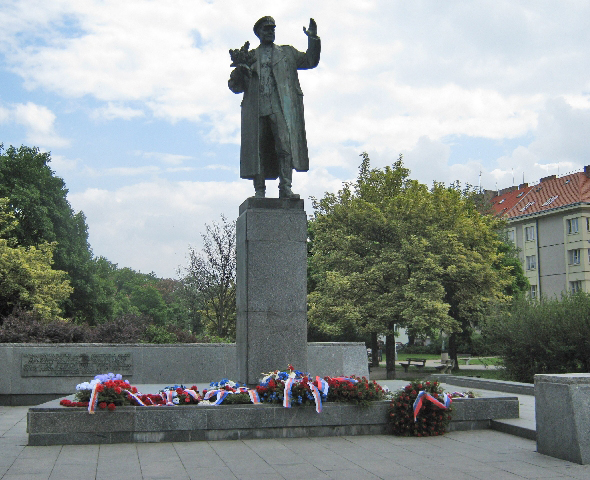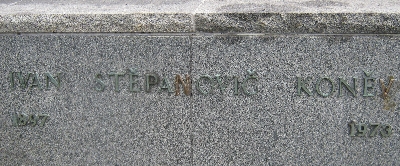

Today is a public holiday here in the Czech Republic, as it is in several other European countries. The public holiday marks the ending of World War Two, sixty-seven years ago, on 8th May 1945.
I took the photograph on the left today. It is of a statue that stands in Námestí Interbrigády, a large square on one side of Jugoslávských partyzánu, the main thoroughfare leading from our nearest Metro station at Dejvická, to Podbaba where we live. And the person it portrays is Marshall Ivan Stepanovich Konev of the Soviet Red Army, who led the troops that liberated Prague from Nazi occupation, finally entering the city early on 9th May 1945, just a few hours after the unconditional surrender of all Nazi troops across Europe, had come into force.
As I wrote in an earlier post on this same topic two years ago, this statue is a rare sight today, anywhere in the Czech Republic or Slovakia, as it features a leading figure of the Soviet Army which, during nearly forty-two years of communism, was regarded as an army of occupation by the people of Czechoslovakia. Nearly all public monuments featuring or seeking to celebrate, ‘Soviet friendship and brotherhood’ have, since the Velvet Revolution of 1989, been quietly removed. But, because it commemorates an event that took place before the communist coup in 1948, it remains standing.
As you can see, a large number of floral tributes have been placed at the foot of the statue in recent days. Some are official, such as the ones from the Czech Military and from the Defence Office of the Czech President. Others are simple bunches of flowers, left by private individuals. Although there is a considerable dislike of Russia and Russians amongst the Czech people today, (see some of the comments on my previous post), there is a recognition that it was the Soviet Army that was responsible for liberating Prague and two thirds of what is now the Czech Republic, early in May 1945.

However, I was intrigued by one large floral tribute pictured here, whose ribbons have an inscription written in a language using the Cyrillic alphabet, presumably Russian. If anyone can tell me what it says or which organisation might be responsible for it, I would love to know.

And I was also intrigued by this inscription on the low wall behind the statue, which refers to the country as the Czechoslovak Socialist Republic, the name used only during the years of communist rule. Whereas elsewhere in the Czech Republic, specific communist logos and references have been removed from war memorials such as in Tábor, here communist nomenclature remains.
Whilst the liberation of the country from Nazi occupation is still marked each year here in the Czech Republic, what has changed since the Velvet Revolution, is the attitude of Czech people towards Germany and the German people. Most Czechs are now freely able to distinguish between Nazi Fascist ideology as exemplified by Hitler’s Third Reich, and present-day democratic Germany, still very much aware of it’s relatively recent past history.
Therefore these days, Germany is the Czech Republic’s biggest trading partner. Germans also travel here in considerable numbers to enjoy the delights of what this country has to offer and in doing so, make a major contribution to the Czech Republic’s tourist income.
On the other hand, although the part played by Russia and the Soviet Red Army to liberate the country from Nazi occupation is still acknowledged each year, those who liberated, in turn became an army of occupation. And although all Russian troops had left Czech soil by June 1991, there remains a strong feeling that Russia still wants to control its former republics and satellite states using its economic power, particularly with regard to the supply and distribution of natural gas.
